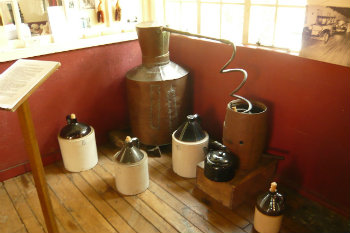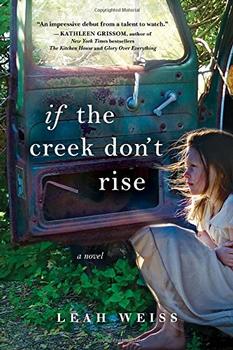Moonshine Mania
This article relates to If the Creek Don't Rise

In If the Creek Don't Rise, Sadie Blue's husband earns his money making and selling moonshine. The trouble caused by alcohol and illegal business is a theme that runs throughout the story. The term moonshine comes from the illicit nature in which it has historically been brewed, in the dark, under cover of "moon shine." Moonshine has made a recent reappearance in public culture. Here are ten things you may not know about the infamous libation.
- It won't make you go blind
Moonshine could get you blind drunk, but it should be a temporary affliction. Poorly made moonshine is another story. It's not the strength of the alcohol that's the problem, it's the methanol, a natural byproduct of the fermentation process. Methanol has a lower boiling point than alcohol (ethanol), and so is first to come from the still. Any respectable moonshiner knows the first batch - and anything produced before the boiling point of ethanol (174°F) - needs to be discarded. Methanol can be highly toxic, even in small quantities, and can lead to blindness and kidney failure. Know your source before you imbibe!
- Yeast makes a difference
Without yeast, there would be no alcohol - legal or illegal. These single-celled organisms occur in the wild all over the world, on every continent including Antarctica. But there are tens of thousands of different strains. Some yeast yield higher amounts of alcohol and others are simply tastier. There's a reason Kentucky bourbon has a flavor all its own, and yeast is a big part of it.
- It comes in different styles and flavors
The term moonshine covers a wide variety of alcohols including whiskey and rum. Alcohol is produced when yeasts ferment any kind of sugar. Moonshine is usually a grain alcohol—corn being a traditional favorite. Bottling liquor was an easier, and sometimes more lucrative, way for farmers to monetize their harvest. Any kind of fruit or even starchy vegetables, such as potatoes can be fermented.
- Distillation is the point of no-return
The process for making beer and wine begins the same way as hard liquor: natural fermentation. In order to create alcohol spirits the fermented liquid must be distilled. Distillation is the process of purifying a liquid by successive evaporation and condensation.
 Copper stills are more than a pretty face
Copper stills are more than a pretty face
Copper stills, which are used to make moonshine, are pretty to look at. But there's a scientific reason that the metal is the choice material for distilleries. During the distillation process, sulfur is produced, which chemically bonds with the copper, producing copper sulfate. As long as the distiller cleans the still, the liquor shouldn't have a nasty sulfur smell.
- Moonshine is made practically everywhere
It might go by another name, or come in a different flavor, but people have been making their own spirits all over the United States—and the rest of the world—since at least 1000 B.C. Even George Washington had a distillery at his estate in Mount Vernon. The Whiskey Rebellion of 1791, which started in Pennsylvania, was in response to the first attempts to tax homemade alcohol. Protests occurred all over the new country, especially in the Midwest frontier areas. And during prohibition, moonshine entrepreneurs were busy everywhere in the USA.
- NASCAR got its start thanks to moonshine
Bootleggers hired to transport moonshine in the early 1900s modified their vehicles to make them faster and easier to maneuver. Before long these fast-driving, risk-loving drivers were racing each other along the back roads. NASCAR was a way to make the races count. Junior Johnson, one of the first NASCAR Hall of Fame Inductees was once arrested for his connection with the family business. President Reagan pardoned him in 1986.
- Moonshine over the years
People have been using and abusing alcohol for most of history. Even the ancient Egyptians took advantage of natural fermentation results. But liquor didn't become moonshine until the government tried to tax it. Prohibition made it illegal—and therefore a lucrative—business. During the Great Depression, it was one way to make a living—bad economic times have always been good for the moonshine business. The sugar rations of World War II ensured that grain spirits stayed in fashion rather than simple sugar-based alcohol.
- (In)famous Women Moonshiners
Whether they were helping their male relatives or handling various steps of the business themselves, women have gotten mixed up in moonshine too. From the legendary "Nancy the Moonshiner" who evaded capture in her own home, to brilliant businesswoman Mary Dowling who set up a distillery in the border town of Juarez Mexico, to Ella Costner, the Poet Laureate of the Smokies in 1970, hard-working women have worked the moonshine business to keep their families fed.
- Moonshine as Medicine?
Some folks swear by the medicinal qualities of moonshine. Mix it with lemon, honey and a touch of ginger to make a potent cough syrup. For treating arthritis, let moonshine steep over yams or poke roots. One old-time remedy suggested curing colic with a mixture of moonshine and tobacco smoke. It's also been used as an antiseptic and anesthesia. Not to mention a good old-fashioned love tonic. No matter what your reason, drink with caution!
Picture of moonshine-making apparatus from Estes-Winn Antique Car Museum
Filed under Cultural Curiosities
 This "beyond the book article" relates to If the Creek Don't Rise. It originally ran in September 2017 and has been updated for the
August 2017 paperback edition.
Go to magazine.
This "beyond the book article" relates to If the Creek Don't Rise. It originally ran in September 2017 and has been updated for the
August 2017 paperback edition.
Go to magazine.
Membership Advantages
- Reviews
- "Beyond the Book" articles
- Free books to read and review (US only)
- Find books by time period, setting & theme
- Read-alike suggestions by book and author
- Book club discussions
- and much more!
-
Just $60 for 12 months or
$20 for 3 months.
- More about membership!

 Copper stills are more than a pretty face
Copper stills are more than a pretty face![]() This "beyond the book article" relates to If the Creek Don't Rise. It originally ran in September 2017 and has been updated for the
August 2017 paperback edition.
Go to magazine.
This "beyond the book article" relates to If the Creek Don't Rise. It originally ran in September 2017 and has been updated for the
August 2017 paperback edition.
Go to magazine.